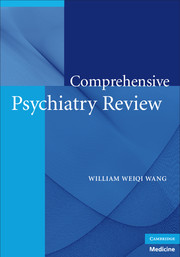Book contents
- Frontmatter
- Contents
- Introduction
- PART I INTELLECTUAL FOUNDATION OF PSYCHIATRY
- PART II EVALUATION AND MEASUREMENT
- PART III PSYCHIATRIC DISORDERS
- 10 Cognitive Disorders
- 11 Addictions: General Consideration
- 12 Addictions: Alcohol-Related Disorders
- 13 Addictions: Nonalcoholic Substance-Related Disorders
- 14 Psychotic Disorders
- 15 Mood Disorders
- 16 Anxiety Disorders
- 17 Somatoform Disorders
- 18 Dissociative Disorders
- 19 Sexual and Gender Identity Disorders
- 20 Eating Disorders and Weight Issues
- 21 Sleep Disorders
- 22 Factitious Disorders and Malingering
- 23 Personality Disorders
- 24 Child and Adolescent Psychiatric Disorders
- 25 Psychosomatic Disorders and Consultation-Liaison Psychiatry
- PART IV PSYCHIATRIC THERAPEUTICS
- PART V NEUROPSYCHIATRY AND RELEVANT NEUROLOGIC CONDITIONS
- PART VI SPECIAL TOPICS
- PART VII REVIEW QUESTIONS
- Bibliography
- Index
13 - Addictions: Nonalcoholic Substance-Related Disorders
from PART III - PSYCHIATRIC DISORDERS
Published online by Cambridge University Press: 18 January 2010
- Frontmatter
- Contents
- Introduction
- PART I INTELLECTUAL FOUNDATION OF PSYCHIATRY
- PART II EVALUATION AND MEASUREMENT
- PART III PSYCHIATRIC DISORDERS
- 10 Cognitive Disorders
- 11 Addictions: General Consideration
- 12 Addictions: Alcohol-Related Disorders
- 13 Addictions: Nonalcoholic Substance-Related Disorders
- 14 Psychotic Disorders
- 15 Mood Disorders
- 16 Anxiety Disorders
- 17 Somatoform Disorders
- 18 Dissociative Disorders
- 19 Sexual and Gender Identity Disorders
- 20 Eating Disorders and Weight Issues
- 21 Sleep Disorders
- 22 Factitious Disorders and Malingering
- 23 Personality Disorders
- 24 Child and Adolescent Psychiatric Disorders
- 25 Psychosomatic Disorders and Consultation-Liaison Psychiatry
- PART IV PSYCHIATRIC THERAPEUTICS
- PART V NEUROPSYCHIATRY AND RELEVANT NEUROLOGIC CONDITIONS
- PART VI SPECIAL TOPICS
- PART VII REVIEW QUESTIONS
- Bibliography
- Index
Summary
Under the commonality of habit forming, each addictive substance has its own unique mechanism and pattern of abuse. Substance use usually provides apparent reward in short term but has extended risk through chronic use.
Some of the now notorious addictive substances were once legitimate medicinal agents. Amphetamine and its derivative methamphetamine were supplied to the soldiers to combat fatigue in the World War II. The use of cocaine and nicotine through chewing the leaves of coca and tobacco were a practice for many centuries among South Americans. The tax from coca leaf trade was once a source of support for some churches. After the isolation of cocaine alkaloid, it was widely used medicinally as an analgesic agent. The use of caffeine and opiate were found as early as the Stone Age. Even today, opioids still serve as the standard against which pain killing agents are measured. Marijuana's medicinal use has been a long time debation given its prominent effects on appetite stimulation and mood relaxation, under the shadow of its addictive nature. Phencyclidine was once patented and marketed as an anesthesic. Hallucinogen and inhalant are more heterogeneous groups with little known medical usage. The years of 1960s and 1970s witnessed increasingly systemic legal regulation on the use of addictive substances. The pathological substance use, though, continues to be debilitating and costly conditions.
DSM-IV-TR categorized 10 groups of substances other than alcohol
▶ Amphetamine
▶ Caffeine
▶ Cannabis
▶ Cocaine
▶ Hallucinogen
▶ Inhalant
▶ Nicotine
▶ Opioid
▶ Phencyclidine (PCP)
▶ Sedative, hypnotic, or anxiolytic
Amphetamine and cocaine intoxication and withdrawal: signs and symptoms
▶ Both intoxication and withdrawal
[…]
- Type
- Chapter
- Information
- Comprehensive Psychiatry Review , pp. 89 - 99Publisher: Cambridge University PressPrint publication year: 2009



